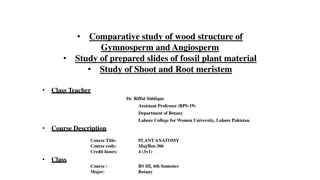Exploring Seed Plant Diversity and Adaptations
Delve into the realm of seed plants, uncovering their unique adaptations for reproduction, their phylogeny with gymnosperms and angiosperms, and the diversity within gymnosperms such as conifers, cycads, gingkophytes, and gnetophytes. Discover the evolutionary success of seed plants through their wa
5 views • 23 slides
Introduction to Gymnosperms: Key Characteristics and Features
Gymnosperms are seed-producing plants with exposed ovules, lacking fruits. They have true roots, stems, and leaves, with majority being tall, woody, perennial plants. Male and female flowers are borne on separate structures, and pollination occurs via wind. Gymnosperms exhibit unique features such a
6 views • 6 slides
Understanding the General Characteristics of Gymnosperms
Gymnosperms, originating in the Paleozoic era, were dominant in the Jurassic and Cretaceous periods. With naked seeds and xerophytic traits, these plants exhibit unique features such as heterospory, symbiotic root associations, and different leaf types. Examples include Cycus, Pinus, and Gnetum. The
5 views • 41 slides
Archegoniates: Primitive Plants with Unique Reproductive Structures
Archegoniates are a group of primitive plants believed to have originated from ancestral green algae. They possess distinct reproductive structures such as archegonia, which house the egg cell and give rise to the sporophytic generation. Heterospory in archegoniates leads to the formation of microsp
1 views • 15 slides
Overview of Bentham and Hooker's Classification System in Plant Taxonomy
Bentham and Hooker's system of classification in plant taxonomy, outlined in Genera Plantarum, provided detailed descriptions of families and genera based on original plant dissections. This classification system has practical value for plant identification, with keys for taxa and subdivisions for l
2 views • 47 slides
Comparative Study of Wood Structure in Gymnosperms and Angiosperms
This course in Plant Anatomy at Lahore College for Women University delves into the detailed examination of wood structures in Gymnosperms and Angiosperms. It involves analyzing prepared slides of fossil plant material, studying shoot and root meristems, and understanding the differences between har
0 views • 9 slides
Understanding Seed Plants: Gymnosperms and Angiosperms
Learn about the adaptations that allow seed plants to reproduce without open water, the importance of seeds, and the differences between gymnosperms and angiosperms. Explore how gymnosperms carry out fertilization without water in their life cycle. Images included.
0 views • 5 slides
Workshop on T.Y.B.Sc. Botany Revised Syllabus Semester VI at R.P. Gogate College of Arts & Science and R.V. Jogalekar College of Commerce
This workshop, held on 18th Feb 2019, introduced the revised syllabus for Semester VI of the T.Y.B.Sc. Botany program at R.P. Gogate College of Arts & Science and R.V. Jogalekar College of Commerce in Ratnagiri. The syllabus covers topics such as plant diversity, form and function, current trends in
0 views • 26 slides
Understanding Seed Anatomy and Germination Processes
Explore the anatomy of seeds, including taxonomic classes like angiosperms and gymnosperms, subclasses within angiosperms, and components of a seed such as the embryo, endosperm, and seed coat. Learn about seed germination conditions, dormancy, and factors like favorable temperature and scarificatio
0 views • 17 slides
Understanding the Classification of Plants - Non-flowering and Flowering Varieties
Explore the diverse world of plants through their classification into non-flowering (mosses, ferns, gymnosperms) and flowering categories. From the simplest mosses to the tall gymnosperms, learn about their characteristics, reproductive methods, and habitat preferences.
0 views • 20 slides
Evolution of Land Plants: Colonization and Adaptations
Land plants evolved from Charophyceans, the closest algal relative, adapting to life on land through characteristics like multicellularity, photosynthesis, and specialized reproductive cycles. They diversified into four main groups: Bryophytes, Pteridophytes, Gymnosperms, and Angiosperms, each with
0 views • 12 slides
Understanding Plant Classification and Characteristics
Discover the classification of plants based on their structures and characteristics, including vascular vs. nonvascular plants, seed plants vs. seedless plants, and the definitions of angiosperms, gymnosperms, dicots, and monocots. Learn about the history of plant classification and how plants are g
0 views • 27 slides
Plant Reproduction and Life Cycles in Biology II for Non-Majors
Explore the complex processes of plant reproduction, life cycles, and the alternation of generations in biology. From the fusion of male and female gametes to the development of sporophytes and gametophytes, delve into the stages and structures involved in the reproduction of gymnosperms and angiosp
0 views • 25 slides
Morphology and Adaptations of Gymnosperms
Explore the characteristics of gymnosperms, including their arborescent sporophyte structure, xerophytic adaptations, and symbiotic relationships with roots and fungi. Learn about the unique features such as the taproot system, vascular cylinder composition, and diverse examples like Taxodium sp. an
0 views • 23 slides
Understanding Plant Evolution and Characteristics
Plants colonized land through various adaptations such as multicellularity and photosynthesis. They exhibit characteristics like chlorophyll, cellulose cell walls, and apical meristems. Plant evolution includes alternation of generations, with gametophytes and sporophytes undergoing meiosis and mito
0 views • 15 slides














